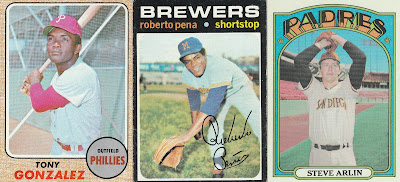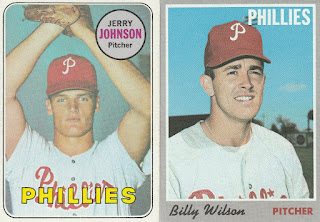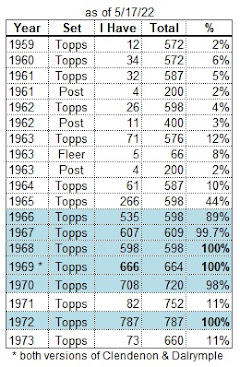Ok folks, I moved about a month ago, and last week I bought a new scanner (which is much easier to use, and without the 5-minute pesky warmup time before the first scan). So now I'm ready to get back onto a blog schedule. As a side benefit while moving, I found the box with all my Phillies yearbooks from the 1960s and 1970s.
--
In January, I posted a review of the 1968 Phillies team. Who did the Phillies protect in the expansion draft following that 1968 season? Well, that was a closely-guarded secret.
The rules were:
- Each NL team protected 15 players on their 40-man roster (or was it in their entire organization?)
- The Expos and Padres took turns selecting from the pool of players, 1 at a time.
- When an established team lost a player, they could add 3 players to their protected list.
- By the end of the draft, each new team had to have selected 3 players from the 10 established teams.
Theoretically, each established team was going to lose their 16th, 20th, 24th, 28th, 32nd, and 36th best players.
(The American League followed the same rules for their draft.)
What follows here is my carefully-considered guess:
1. Who I think the Phillies protected prior to the October 1968 expansion draft (listed in what I think was their priority order):
Richie Allen (1B)
Five seasons and 145 homeruns into his career, Allen was rubbing management’s last nerve raw, but you don’t give away a player like this.
Chris Short (SP)
Short was the team’s pitching ace. He won 18, 20, 9, and 19 games from 1965-68, but missed most of 1969 to a back injury.
Woodie Fryman (SP)
This lefthander was acquired prior to the 1968 season from the Pirates, where he was named to the Topps All-Rookie team in 1966.
Rick Wise (SP)
Wise came up through the Phillies’ system. After debuting in 1964, he played for the Phillies for part of 1966. In his first full season (1967) he began as the #5 starter and moved up to #4. By 1971 he was the team’s ace.
A pair of promising rookies:
Don Money (SS)
Money was acquired from the Pirates before the 1968 season, and was selected to the Topps All-Rookie team in 1969.
Larry Hisle (CF)
Hisle claimed the center field job as a rookie in 1969, and was also selected to the Topps All-Rookie team.
Johnny Callison (RF)
Callison has been with the Phillies since 1960. He had huge HR and RBI years in ’64 and ’65, and although he began declining in 1966, he was still the team’s #2 slugger.
Cookie Rojas (2B)
Rojas began as a utility player, and was a competent 2nd baseman as a regular since 1966.
John Briggs (OF)
With the Phillies since 1964, the team had high hopes for Briggs, whose power didn’t switch on until he moved to the Brewers in 1971.
Three of their top prospects:
Larry Bowa (SS)
Bowa was a highly-touted AA prospect in 1968, with a bright future in Philly.
Denny Doyle (2B)
The Phillies often touted the Bowa/Doyle keystone combo back in the day, although they didn’t play together until 1968 in double-A ball.
Lowell Palmer (SP)
20-year-old Palmer was the Phillies’ top pitching prospect in triple-A in 1968 (13-8, 191 strikeouts).
Grant Jackson (RP)
Jackson’s rookie season was in 1967. He was the only lefty in the bullpen during the late 1960s.
Mike Ryan ( C )
An excellent defensive catcher but poor hitter, Ryan was acquired from the Red Sox after the 1967 season. He platooned with veteran Clay Dalrymple in 1968. I thought maybe the Phillies would leave both catchers unprotected with the idea that no team would select these 2 lunch-pailers, but they had just acquired him in the previous off-season, so maybe didn’t want to risk losing him. Had they lost him, it would have been another year with Dalrymple in 1969.
Barry Lersch (SP)
Lersch was 13-8 with 114 strikeouts for the Phillies’ AAA team in 1968, 2nd best after Palmer.
2. These players were lost in the expansion draft:
Gary Sutherland (INF)
He was the 1st Phillies’ player taken in the draft. Gary spent the ’68 season as a utility player, backing up a career minor-leaguer at shortstop after the team’s first 2 options didn’t work out. Hard to believe Sutherland was the best Phillie available. Bill White comes to mind first, along with Tony Gonzalez, and 34-year-old reliever Turk Farrell.
Mike Wegener (SP)
He was the 2nd Phillies’ player taken in the draft.
Wegener was 10-13 with 169 strikeouts in class-A in 1965, but struggled for the next 3 seasons.
Larry Jackson (SP)
He was the 3rd Phillies’ player taken in the draft.
Jackson was 37 and had just finished his 14th season. No reason to protect him, with all the other arms.
Tony Gonzalez (CF)
He was the 4th Phillies’ player taken in the draft.
With Larry Hisle set to take over in center field, the Phillies didn’t
need to protect Gonzalez or Don Lock. My guess is that if one of them
were selected, the other would be subsequently protected, to provide
outfield depth.
Roberto Pena (SS)
He was the 5th Phillies’ player taken in the draft.
After spending most of his career in the minors, Pena was the Phillies
regular shortstop for most of 1968, after first Don Money failing his
early-season tryout, then Bobby Wine was lost for the season with a bad
back.
Steve Arlin (SP)
He was the 6th Phillies’ player taken in the draft.
Arlin struck out 116 in 110 innings as a class-A rookie in 1966, then
struggled for the next 2 seasons. As the 6th Phillie taken, he was
theoretically the organization’s 36th-best player – probably about
right.
3. Why I think these players also were not protected:
Bill White (1B)
- A major-leaguer since 1956, White hit 20 to 27 homers every season from 1961-66, but his numbers fell off sharply after 1966, Partially because of missing time with injuries in both seasons, but also because of advancing age (34 in 1968). With Richie Allen moving in to first base in 1969, White was not in the team’s future plans. I guess they gambled that nobody would select him in the early rounds.
Tony Taylor (INF)
- Taylor was the team’s 2nd baseman from 1960-64. He played as much as any regular from 1966-70, shuffling around the diamond (2B/1B/3B) filling in for injured players. Still, you can’t protect utility players in the first 15 slots, especially at age 32.
Turk Farrell (RP)
- Farrell was the Phillies’ closer in ’67 and ’68, but at age 34 it didn’t make sense to protect him.
Dick Hall (RP)
- Hall was 3 years older than Farrell, and although they both joined the Phillies’ bullpen in 1967, Hall played much less in ’68 than in the previous season. Besides, the Phillies released him a week after the draft.
Clay Dalrymple ( C )
- Dalrymple was the Phillies' starting catcher from 1960-66, and platooned in ’67 and ’68. At age 31 in 1968, and batting .172 and .207 in his last 2 seasons, there was no need to protect him. In January he was traded to the Orioles for outfield prospect Ron Stone.
Bobby Wine (SS)
- Wine was the team’s primary shortstop from 1962-65, and in 1967. He missed most of 1968 with a back injury, and hit under .200 in his last 2 seasons as a Phillie. With Don Money ready at shortstop, it was time to move on.
Gary Wagner (RP)
- The right-handed Wagner pitched in 59 games for the Phillies as a rookie in 1965, then spent the next 2 seasons in the minors. He returned in ’68, pitching 44 games with a 4-4 record a 3.00 ERA, but you can’t protect everybody.
Don Lock (OF)
- Lock was acquired from the Senators before the 1967 season to provide outfield punch which never materialized. Platooning with Briggs and/or Gonzalez for all of ’67 and ’68, he was certainly expendable. My theory is that if either Gonzalez or Lock was selected in the draft, the other may have been re-protected for depth. Once Ron Stone was acquired in January, Lock was literally unnecessary, and was traded to the Red Sox in early-May for a bag with 1 bean in it (a player with 1 career MLB at-bat).
Jerry Johnson (SP)
- The Phillies’ #5 starter for the last 2 months of 1968 (as a rookie), he compiled a 4-4 record, but there were too many others ahead of him.
Jeff James (SP/RP)
- James was also a rookie in 1968. Working mostly out of the bullpen, he got the occasional 5th start until Johnson was called up in August. I think the Phillies had soured on him during that season.
Rick Joseph, John Boozer, Doug Clemens, John Sullivan
Backup players who would not be missed, even if somehow selected.
4. Unprotected minor-league prospects:
Class AAA:
Billy Wilson (RP)
- Wilson was 8-6 in triple-A in 1968, at age 25. He had a history of arm troubles, so probably wasn’t as attractive to other teams.
Al Raffo (SP)
- Raffo was in the Phillies’ organization since 1963, and compiled records of 11-7, 14-10, 12-6, and 11-7 in ’63, ’64, ’67, and ’68, but never got a call-up until late-April 1969, so the Phillies must not have been very high on him.
Larry Colton (SP)
- Colton had good numbers in 3 minor-league seasons (1965-67) but pitched in only 1 game for the Phillies in 1968, and was injured for much of that year, so at age 26 his future was suspect.
Class AA:
Gene Rounsaville (SP)
- Gene was 12-10 with 153 strikeouts in class A in 1966, but spent the next 2 seasons in double-A. Although compiling a 14-5 record and 1.76 ERA in ’68, his strikeouts in those two AA seasons were almost half of his class-A mark.
Pat Bayless (SP) - In 1967, the 19-year-old Bayless was 18-8 with 217 strikeouts in class-A ball. The following season in double-A, he was 12-8 with a 1.76 ERA and 130 strikeouts. Although he pitched in the Phillies’ organization through 1971, he never made the majors.
Luis Peraza (RP)
- Peraza was 9-8 with 156 strikeouts in 1967 (class-A) and 13-3 in 1968 (AA), but never reached that level again.
Ron Allen (1B)
- Richie’s brother was a double-A prospect, but 9 homers and 61 RBI is not a good sign for a 1st baseman.
Dave Watkins ( C )
- Watkins was the team’s AA catcher in 1968, batting .264 in 117 games. With the non-existent hitting of their major-league catchers, and aging ex-big-league backstops at AAA, Watkins was worth keeping.
Class A:
Billy Champion (SP)
- Champion was 15-5 with 193 strikeouts in 1968. That it was in class-A ball made it easier for the Phillies to hide him, than Palmer or Lersch.
Ken Reynolds (SP)
- Reynolds was 10-5 with 132 strikeouts at age 21 in 1968. He was also 13-10 with 225 K’s in the previous season.
Dave Bennett (SP)
- In the Phillies’ organization since age 17 in 1963, Bennett had a 1-game tryout with the Philies in 1964, but never made it back, despite playing in their farm system through 1969, and posting 11-9 and 11-5 records in ’67 and ’68. He made it to AA and AAA from 1964-65, but regressed to single-A from 1966-68.
Joe Lis (3B)
- Lis hit over 30 homers and collected over 90 RBI in each of 1967 and 1968 while in class-A, and hit .293 in 1968, easily the organization’s top minor-league slugger. He was converted to an outfielder in 1969.
Gene Stone (1B)
- Stone hit 21 and 20 homers in class-A in 1967 and 1968. Advancing to double-A in 1969, he was called up to the Phillies for 28 at-bats in 1969, the sum of his major-league career. That was his last pro season. Curiously, he never played in triple-A.
5. Subsequently protected players:
Following Sutherland’s selection:
Champion – Good numbers in Class A won’t stay hidden for long.
Lis – Same reason as Champion.
Taylor – Need some infield depth.
Following Wegener’s selection:
(That Wegener was selected 2nd makes me think that Palmer, Lersch, and Champion were already off the board.)
Wagner – Gotta start building a bullpen.
White – May be a useful trade chip, if not given away in the draft.
Rounsaville – Numbers were too good to leave exposed for another round.
Following Jackson’s selection:
Bayless – Numbers were too good to leave exposed for another round.
Watkins – Best-hitting catcher in the entire organization.
Farrell – Someone needed to head up the 1969 bullpen.
Following Gonzalez’ selection:
Reynolds – At age 21, can only get better. (D’oh!)
Ron Allen – Good prospect, even without corner infield power.
Lock – For outfield depth.
Following Pena’s selection:
Johnson – Need to round out starting rotation.
Wilson – AAA bullpen prospect.
Gene Stone (no photo) – Good numbers, even if only class-A.
(Since pitcher Steve Arlin was taken as the 6th pick, pitching prospects Palmer, Lersch, Champion, Reynolds, Rounsaville, and Bayless would almost certainly have been off the board already.)
6. Veterans not protected or drafted:
Hall,
Dalrymple,
Wine,
James
Joseph,
Boozer,
Clemens,
Sullivan
7. Epilogue:
When Larry Jackson retired rather than report to the Expos, the Phillies offered a list of players to the Expos, for them to choose 1 player as compensation. They chose Bobby Wine. I suspect the list looked like this:
Bobby Wine
Jeff James
Rick Joseph
John Boozer
John Sullivan
Doug Clemens (if not already retired)
Well, that's my story, and I'm sticking to it. CommishBob, maybe you can take a crack at the Orioles. I read somewhere that Jim Palmer (rehabbing in the minors for most of '67 and '68) was left unprotected (and fortunately was passed over).
Wait, I may have just worn out my keyboard! LOL
Friday, May 12, 2017
Subscribe to:
Posts (Atom)
















.jpg)

.jpg)
.jpg)















